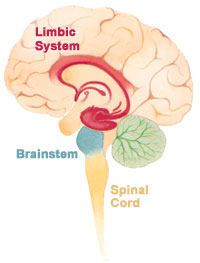- Limbic encephalitis
Infobox_Disease
Name = PAGENAME

Caption = Thelimbic system within the brain.
DiseasesDB = 30707
ICD10 = ICD10|G|13|1|g|10
ICD9 =
ICDO =
OMIM =
MedlinePlus =
eMedicineSubj =
eMedicineTopic =
MeshID = D020363Limbic encephalitis is a form of
encephalitis .In a small number of cases, the pathogens responsible for encephalitis attack primarily the
limbic system (a collection of structures at the base of the brain responsible for basicautonomic functions), often causing memory deficits similar to those observed inAlzheimer's disease orCreutzfeldt-Jakob disease (although limbic encephalitis does not cause the same cognitive deficits as these diseases. [ [http://www.uiowa.edu/~c064s01/nr059.htm nradnormal.html ] ] However, for 20% of people with the diagnosis of limbic encephalitis an MRI will not show any neurological abnormalities [ [http://www.communityoncology.net/journal/articles/0408491.pdf Paraneoplastic limbic encephalitis associated with small-cell lung cancer ] ]60% of the time, limbic encephalitis is paraneoplastic in origin. [ [http://www.communityoncology.net/journal/articles/0408491.pdf Paraneoplastic limbic encephalitis associated with small-cell lung cancer ] ]
Paraneoplastic limbic encephalitis (PLE) is a particularly severe form of limbic encephalitis caused byneoplasms most commonly associated with small cell lung carcinoma. Whereas the majority of encephalitides areviral in nature, PLE is often associated withcancer . In fact, it is thought that up to 1 in 100 people with cancer have paraneoplastic limbic encephalitis which is commonly misdiagnosed as neurological diseases such as Alzheimer's. [ [http://www.postgradmed.com/issues/2005/05_05/barrett_tab1.htm Barrett Table 1 ] ]References
External links
*
Wikimedia Foundation. 2010.
